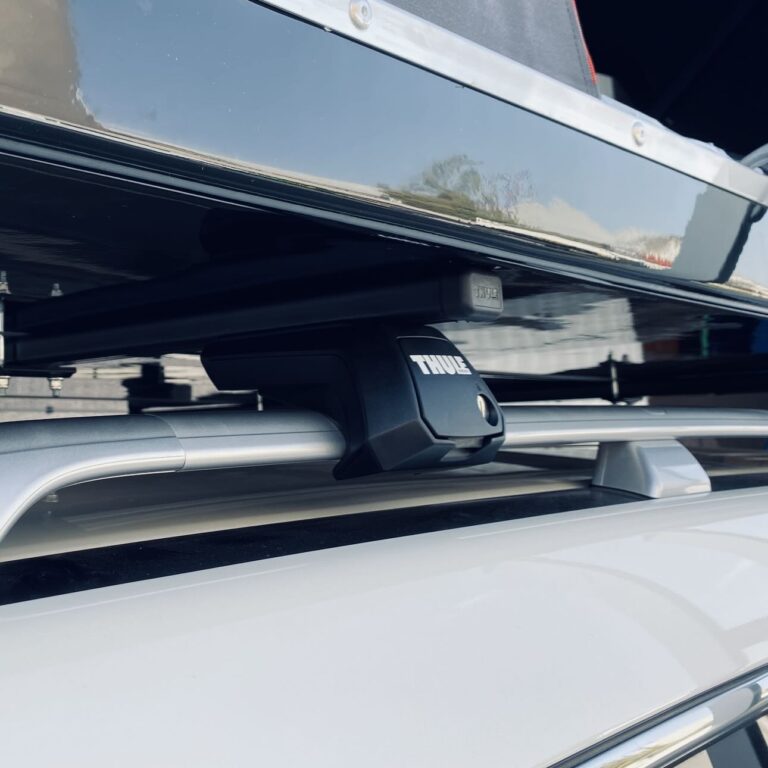Buyer's guide
Better prepared
Four basics to check before you buy
Check the roof load limit of your car
1

The roof load limit is the maximum weight you can add to your car roof. It is differentiated between “dynamic” roof load (moving) and “static” roof load (not moving). The dynamic roof load varies between car models and usually ranges between 50kg and 100kg. To install an Autohome roof top tent, around 75kg dynamic load are sufficient.
To ensure your car stays within safe and legal conditions when installing the roof top tent. Adding weight to the top of your car changes its center of gravity and thus impacts the handling, stability and risk to roll over.
In the owners manual of your car.
Study careful, as the limit may vary depending of the configuration of your car, e.g. sunroof, wheel size, engine etc. In case the owners manual is not available, contact the dealer or search for it in the internet.
2
Check the height of your parking

Installing a roof top tent on to your car will increase the overall height of your vehicle. The total height increase depends on the roof rack and the model of tent you choose. This applies not only to your parking situation at home, but also to every other parking you frequent with your car, like work, the mall or your gym.
TIP: Install the TENTLIFT system in your garage to take the tent off whenever not in use.
To ensure you can still park your car in the desired spots after the tent is installed and to prevent potential damages to the tent, the car or building infrastructure like a sprinkler system.
Underground parkings usually have a height limit sign on the entrance that specifies the limit in meter. Else measure the height yourself or check with the building / community management.
3
Check the type of roof on your car

Car manufacturers usually prepare their cars to carry cargo on the roof by adding a railing to the roof.. The design varies between the different cars and models. The most common types of car roofs are are closed railings, fixpoints, open railings and rain gutters.
By looking onto the roof of your car.
To find the right roof rack for your car model, Thule has a configurator on their website, that works great as a starting point for research.
4
Select the right roof rack

A roof rack consists of a pair of cross bars that run from side to side on your car roof and are attached to the railing or directly to the car roof (fix points) or to the rain gutter.
The roof rack carries the rooftop tent. The selection of roof rack is a extremely crucial decision that can make attaching and detaching the tent easy or almost impossible.
Depending on you roof type you might require a car specific attachment which needs to be ordered.
We recommend Thule and Rhino-Rack.
1
Check the roof load limit of your car
The roof load limit is the maximum weight you can add to your car roof. It is differentiated between “dynamic” roof load (moving) and “static” roof load (not moving). The dynamic roof load varies between car models and usually ranges between 50kg and 100kg. To install an Autohome roof top tent, around 75kg dynamic load are sufficient.
To ensure your car stays within safe and legal conditions when installing the roof top tent. Adding weight to the top of your car changes its center of gravity and thus impacts the handling, stability and risk to roll over.
In the owners manual of your car.
Study careful, as the limit may vary depending of the configuration of your car, e.g. sunroof, wheel size, engine etc. In case the owners manual is not available, contact the dealer or search for it in the internet.

2
Check the height of your parking
Installing a roof top tent on to your car will increase the overall height of your vehicle. The total height increase depends on the roof rack and the model of tent you choose. This applies not only to your parking situation at home, but also to every other parking you frequent with your car, like work, the mall or your gym.
TIP: Install the TENT LIFT system in your garage to take the tent off whenever not in use.
To ensure you can still park your car in the desired spots after the tent is installed and to prevent potential damages to the tent, the car or building infrastructure like a sprinkler system.
Underground parkings usually have a height limit sign on the entrance that specifies the limit in meter. Else measure the height yourself or check with the building / community management.

3
Check the type of roof on your car
Car manufacturers usually prepare their cars to carry cargo on the roof by adding a railing to the roof. The design varies between the different cars and models. The most common types of car roofs are are closed railings, fixpoints, open railings and rain gutters.
The roof top tent needs to be attached to the car in a secure and safe manner. Ideally easily removable and without any drilling or changes to the car roof. This is achieved through installation of a roof rack, that connects the tent with the car. Roof racks are car model / roof type specific, hence why it is crucial to understand what type of roof your car has.
Just hace a look onto the roof of your car.
If in doubt, send us a picture on whatsapp and we confirm what roof type it is.

4
Check which roof rack you need
A roof rack consists of a pair of cross bars that run from side to side on your car roof and are attached to the railing or directly to the car roof (fix points) or to the rain gutter.
The roof rack carries the rooftop tent. The selection of roof rack is a extremely crucial decision that can make attaching and detaching the tent easy or almost impossible.
Depending on you roof type you might require a car specific attachment which needs to be ordered.
We recommend Thule and Rhino-Rack.

